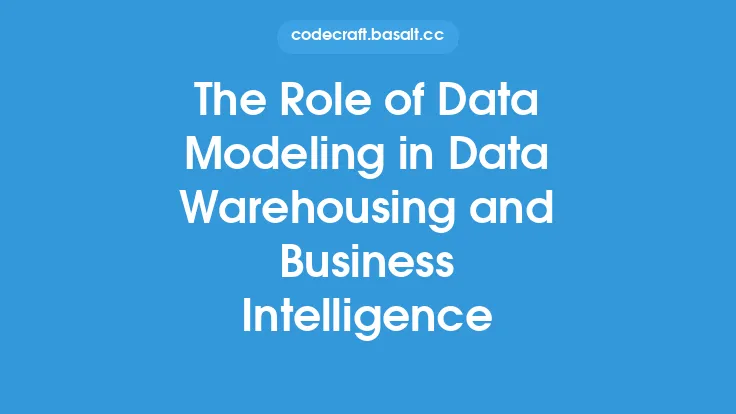Data modeling is a crucial aspect of database systems, as it enables organizations to effectively manage and analyze their data. When it comes to common business domains, there are several data modeling patterns that can be applied to ensure data consistency, accuracy, and scalability. In this article, we will explore some of the most common data modeling patterns for various business domains, including sales, customer relationship management, inventory management, and more.
Introduction to Data Modeling Patterns
Data modeling patterns are pre-defined templates or structures that can be used to model data for specific business domains. These patterns are designed to capture the key entities, attributes, and relationships that are relevant to a particular domain, and can be used to create a robust and scalable data model. By using data modeling patterns, organizations can reduce the time and effort required to develop a data model, and can ensure that their data is consistent and accurate.
Sales and Order Management
In the sales and order management domain, there are several data modeling patterns that can be applied. One common pattern is the "Order-to-Cash" pattern, which captures the key entities and relationships involved in the order-to-cash process, including customers, orders, products, and payments. This pattern typically includes the following entities:
- Customer: captures customer information, such as name, address, and contact details
- Order: captures order information, such as order date, order total, and status
- Product: captures product information, such as product name, description, and price
- Payment: captures payment information, such as payment date, payment amount, and payment method
The Order-to-Cash pattern also includes relationships between these entities, such as the relationship between a customer and an order, or between an order and a product.
Customer Relationship Management
In the customer relationship management (CRM) domain, there are several data modeling patterns that can be applied. One common pattern is the "Customer Interaction" pattern, which captures the key entities and relationships involved in customer interactions, including customers, contacts, accounts, and activities. This pattern typically includes the following entities:
- Customer: captures customer information, such as name, address, and contact details
- Contact: captures contact information, such as name, title, and contact details
- Account: captures account information, such as account name, account type, and account status
- Activity: captures activity information, such as activity type, activity date, and activity status
The Customer Interaction pattern also includes relationships between these entities, such as the relationship between a customer and a contact, or between a contact and an activity.
Inventory Management
In the inventory management domain, there are several data modeling patterns that can be applied. One common pattern is the "Inventory Management" pattern, which captures the key entities and relationships involved in inventory management, including products, inventory levels, and warehouse locations. This pattern typically includes the following entities:
- Product: captures product information, such as product name, description, and price
- Inventory Level: captures inventory level information, such as quantity on hand, quantity available, and reorder point
- Warehouse Location: captures warehouse location information, such as location name, location address, and location capacity
The Inventory Management pattern also includes relationships between these entities, such as the relationship between a product and an inventory level, or between an inventory level and a warehouse location.
Financial Management
In the financial management domain, there are several data modeling patterns that can be applied. One common pattern is the "General Ledger" pattern, which captures the key entities and relationships involved in financial accounting, including accounts, transactions, and journals. This pattern typically includes the following entities:
- Account: captures account information, such as account name, account type, and account balance
- Transaction: captures transaction information, such as transaction date, transaction amount, and transaction type
- Journal: captures journal information, such as journal name, journal type, and journal entry
The General Ledger pattern also includes relationships between these entities, such as the relationship between an account and a transaction, or between a transaction and a journal.
Human Resources Management
In the human resources management domain, there are several data modeling patterns that can be applied. One common pattern is the "Employee Management" pattern, which captures the key entities and relationships involved in employee management, including employees, jobs, and departments. This pattern typically includes the following entities:
- Employee: captures employee information, such as name, address, and contact details
- Job: captures job information, such as job title, job description, and job requirements
- Department: captures department information, such as department name, department description, and department manager
The Employee Management pattern also includes relationships between these entities, such as the relationship between an employee and a job, or between a job and a department.
Supply Chain Management
In the supply chain management domain, there are several data modeling patterns that can be applied. One common pattern is the "Supply Chain Operations" pattern, which captures the key entities and relationships involved in supply chain operations, including suppliers, products, and shipments. This pattern typically includes the following entities:
- Supplier: captures supplier information, such as supplier name, supplier address, and supplier contact details
- Product: captures product information, such as product name, description, and price
- Shipment: captures shipment information, such as shipment date, shipment quantity, and shipment status
The Supply Chain Operations pattern also includes relationships between these entities, such as the relationship between a supplier and a product, or between a product and a shipment.
Conclusion
In conclusion, data modeling patterns are a powerful tool for organizations to manage and analyze their data. By applying these patterns to common business domains, organizations can ensure data consistency, accuracy, and scalability. The patterns outlined in this article, including the Order-to-Cash, Customer Interaction, Inventory Management, General Ledger, Employee Management, and Supply Chain Operations patterns, can be used to create a robust and scalable data model that meets the needs of various business domains. By using these patterns, organizations can reduce the time and effort required to develop a data model, and can ensure that their data is consistent and accurate.





